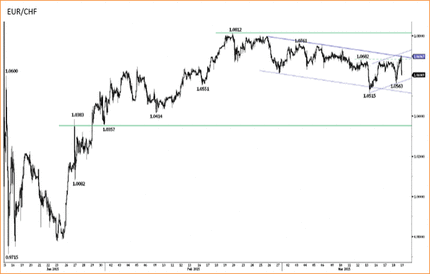Forex News and Events
The SNB maintains the status quo as widely expected. The negative impacts of the franc appreciation post-January 15th is filtering visibly into the economic data. Swiss trade surplus narrowed to 2.47 billion in February (the lowest since September 2010) as exports dropped 2.8% (vs +2.9% a month ago) and imports surged 3.1% /vs -2.2% prev). The weakness in Swiss trade balance should continue as Swiss products become less competitive due to higher franc, while the Eurozone neighbors have hard time stepping out of the economic weakness. The growth and inflation forecasts have been revised down significantly. The Swiss deflation is now expected to ease to -1.0% from 0.2% previous forecast, while the economic growth should decelerate to 0.9% in 2015 verse 3.1% forecasted formerly. Given the weakness in Europe, almost 1% growth is an optimistic forecast. There is increasing probability for the Swiss growth to step in negative territories in the first half of 2015 as the economy needs at least two quarters to absorb and to stabilize post-EUR/CHF peg shock. The recovery from Q3 is subject to downside risks, contingent on the pace of Eurozone’s economic activity pick-up. The euroswiss futures advanced to 110.92 with open interest spike at 66710 (vs 36601 average over the past 15 days). The post-SNB money market pricing confirms that the anxiety on more negative rates will remain in the headlines as selling pressures on EUR are not ready to dissipate. Given the global macroeconomic setting, the SNB has room to pull the rates lower in case of emergency. The market should easily absorb 15-25 basis point cut should the EUR risks materialize. (Grexit, Greece insolvability, rising protests against the anti-austerity and the ECB). The SNB is suspected to purchase sizeable amount of EUR to maintain the EUR/CHF within its implicit 1.05/1.10 range. Post-FOMC recovery in EUR will certainly anchor the EUR/USD market within 1.0458/1.0870 (Mar 16th low / Fib 38.2% on Feb-Mar drop) area and allow the SNB to take a deep breather before fresh turmoil.
Surprise decisions out of Scandies
Norges Bank surprisingly refrained from cutting its deposit rates lower from 1.25%, following the unscheduled 15 basis cut from Riksbank yesterday. “There are prospects for a reduction in the key policy rate” said Norges Bank Governor Olsen, especially to sustain Norwegian economy from low oil prices. EUR/NOK plunged to 8.6474 post-decision, pulling out the 100, 50 day moving averages in a single move. The EUR negative sentiment should pave the way toward the 200-dma (8.5173), that has lately acted as support in March 5/6th.
In Sweden, Riksbank cut the repo rate from -0.10% to -0.25% in an unscheduled meeting yesterday and announced to extend its government bond purchases by 30 billion to 40 billion SEK. The disinflation in the Euro-zone, lower oil prices and the delay in economic recovery almost guarantee that the inflation will miss bank’s 2.0% by far, despite the slight pick-up lately. “There are signs that inflation has bottomed out and is beginning to rise, but the recent appreciation of the krona risks breaking this trend” says the bank. This week surprise action reinforces the credibility of Riksbank’s position against any SEK appreciation verse EUR. EUR/SEK has bottomed at 9.0552 on March 12th amid the heavy sell-off across the EUR-complex accelerated the fall. The ongoing downside risks on EUR signals a challenging upside, while the recent Riksbank cut should allow the EUR/SEK to take a breather in the short-run. As knee-jerk reaction, EUR/SEK rallied from 9.1591 to 9.3613, the MACD stepped in the green zone. Lower SEK rates should build a bottom at 9.20/30 region (including option bids, Fib 23.6% on both Oct’14-Dec’14 rally and Dec’14-Mar’15 sell-off and the 200-dma) should the EUR sell-off eases amid the FOMC relief.
Weakness in EUR/CHF worries
This report has been prepared by Swissquote Bank Ltd and is solely been published for informational purposes and is not to be construed as a solicitation or an offer to buy or sell any currency or any other financial instrument. Views expressed in this report may be subject to change without prior notice and may differ or be contrary to opinions expressed by Swissquote Bank Ltd personnel at any given time. Swissquote Bank Ltd is under no obligation to update or keep current the information herein, the report should not be regarded by recipients as a substitute for the exercise of their own judgment.
Recommended Content
Editors’ Picks
EUR/USD holds below 1.0750 ahead of key US data

EUR/USD trades in a tight range below 1.0750 in the European session on Friday. The US Dollar struggles to gather strength ahead of key PCE Price Index data, the Fed's preferred gauge of inflation, and helps the pair hold its ground.
USD/JPY stays firm above 156.00 after BoJ Governor Ueda's comments

USD/JPY stays firm above 156.00 after surging above this level on the Bank of Japan's decision to leave the policy settings unchanged. BoJ Governor said weak Yen was not impacting prices but added that they will watch FX developments closely.
Gold price oscillates in a range as the focus remains glued to the US PCE Price Index

Gold price struggles to attract any meaningful buyers amid the emergence of fresh USD buying. Bets that the Fed will keep rates higher for longer amid sticky inflation help revive the USD demand.
Bitcoin Weekly Forecast: BTC’s next breakout could propel it to $80,000 Premium

Bitcoin’s recent price consolidation could be nearing its end as technical indicators and on-chain metrics suggest a potential upward breakout. However, this move would not be straightforward and could punish impatient investors.
US core PCE inflation set to signal firm price pressures as markets delay Federal Reserve rate cut bets

The core PCE Price Index, which excludes volatile food and energy prices, is seen as the more influential measure of inflation in terms of Fed positioning. The index is forecast to rise 0.3% on a monthly basis in March, matching February’s increase.
